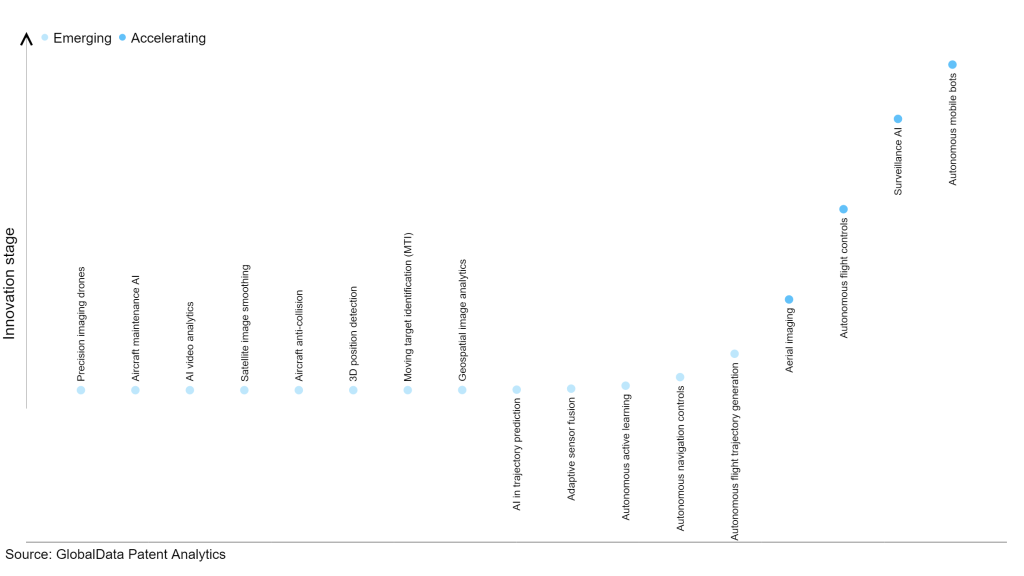The aerospace and defense industry continues to be a hotbed of patent innovation. Activity is driven by developments in artificial intelligence (AI) and machine learning, and the growing importance of technologies such as drones, satellite technology, and big data. In the last three years alone, there have been over 237,000 patents filed and granted in the aerospace and defense industry, according to GlobalData’s report on Artificial intelligence in defense: moving target identification (MTI). Buy the report here.
However, not all innovations are equal and nor do they follow a constant upward trend. Instead, their evolution takes the form of an S-shaped curve that reflects their typical lifecycle from early emergence to accelerating adoption, before finally stabilizing and reaching maturity.
Identifying where a particular innovation is on this journey, especially those that are in the emerging and accelerating stages, is essential for understanding their current level of adoption and the likely future trajectory and impact they will have.
110 innovations will shape the aerospace and defense industry
According to GlobalData’s Technology Foresights, which plots the S-curve for the aerospace and defense industry using innovation intensity models built on over 206,000 patents, there are 110 innovation areas that will shape the future of the industry.
Within the emerging innovation stage, precision imaging drones, aircraft maintenance AI, and AI video analytics are disruptive technologies that are in the early stages of application and should be tracked closely. Aerial imaging, autonomous flight controls, and surveillance AI are some of the accelerating innovation areas, where adoption has been steadily.
Innovation S-curve for artificial intelligence in the aerospace and defense industry

Moving target identification (MTI) is a key innovation area in artificial intelligence
Moving target identification (MTI) is a technique used in various industries such as autonomous driving and military applications to detect and classify moving objects within a specified area. MTI utilizes various sensing technologies, such as light and detection ranging (LiDAR) sensors, cameras, and millimeter-wave radars, to detect and track objects, and machine learning algorithms to classify them.
GlobalData’s analysis also uncovers the companies at the forefront of each innovation area and assesses the potential reach and impact of their patenting activity across different applications and geographies. According to GlobalData, there are 150+ companies, spanning technology vendors, established aerospace and defense companies, and up-and-coming start-ups engaged in the development and application of moving target identification (MTI).
Key players in moving target identification (MTI) – a disruptive innovation in the aerospace and defense industry
‘Application diversity’ measures the number of applications identified for each patent. It broadly splits companies into either ‘niche’ or ‘diversified’ innovators.
‘Geographic reach’ refers to the number of countries each patent is registered in. It reflects the breadth of geographic application intended, ranging from ‘global’ to ‘local’.
Patent volumes related to moving target identification
Source: GlobalData Patent Analytics
Boeing is one of the leading patent filers in moving target identification. The company has filed patents related to the method and system of reducing the effect of degraded visual environments (DVE) on LIDAR return.
The LiDAR system effectively eliminates backscatter from the DVE, utilizing a spatial light modulator. It enables the detection of minute quantities of directly reflected photons from a target surface. In cases where the target is not initially detected, the LIDAR undergoes iterative scanning up to its maximum available depth of focus until the target is successfully acquired. This LiDAR system is particularly valuable for the autonomous landing of vertical take-off and landing (VTOL) aerial vehicles in situations where the anticipated landing location is approximately known but remains obscured by DVE media, such as smoke, dust, fog, or similar conditions.
Boeing was selected by the US Air Force in February 2023 to develop a prototype aircraft as a successor of airborne warning and control system (AWACS) to provide airborne moving target indication, battle management, command and control, and advanced multi-role electronically scanned array (MESA) radar capabilities. .
Some other significant patent filers in the moving target identification space include Thales, Cubic, and Israel Aerospace Industries.
In terms of application diversity, NVIDIA, Aurora Operations, and Samsung are some of the leading innovators. By means of geographic reach, some of the leading patent filers include Seoul Robotics, Toshiba, and Boeing.
To further understand the key themes and technologies disrupting the aerospace and defense industry, access GlobalData’s latest thematic research report on Artificial Intelligence (AI) in Defense.
Data Insights
From

The gold standard of business intelligence.
Blending expert knowledge with cutting-edge technology, GlobalData’s unrivalled proprietary data will enable you to decode what’s happening in your market. You can make better informed decisions and gain a future-proof advantage over your competitors.



